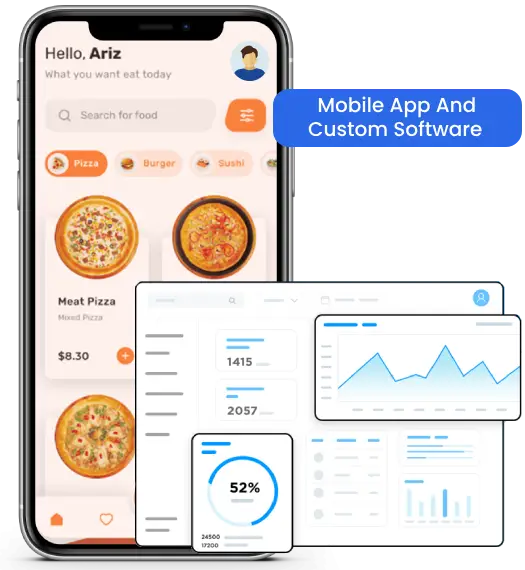In a recent report by Research and Markets, it was revealed that the retail analytics market is expected to grow at an 18% rate between 2019 and 2025. The market valuation is expected to surge by 9.5 billion in the coming years. The flabbergasting number reveals the potential retail analytics market has.
Data is like raw material for a business that wishes to understand the market, predict future prospects, expand its services and cater to the growing market. Without an adequate amount of data, it will not be possible to make data-driven decisions and propel the business to new heights.
We all know that the retail industry is driven by a huge consumer base therefore data is a big deal. However, retailers have to face constant challenges from all directions, from customers, resellers, merchandisers to campaigning, and store inventory operations. By leveraging the power of data and modern filtration methodologies, it is easy for retailers to understand consumer behavior, forecast demands, enhance inventory operations and improve operational efficiency.
Technological Incorporation in Retail
In the recent few times, technological advancements have significantly transformed the whole retail industry. Digital stores now replace traditional brick-and-mortar storefronts, and modern software has taken over the task of writing down every detail on paper. Technology governs the entire retail landscape, bringing convenience to both consumers and retailers.
The innovative and reliable tech-backed solutions simplify the lives of the customers but also allow retail businesses to extract crucial data that can be used later. Utilizing the data and arranging it in an organized manner for better understanding is crucial for business prospects. It allows you to understand market possibilities and convert them into fruitful opportunities that will multiply the returns.
What is Retail Data Analytics?
Retail data refers to the business information involved in retail such as sales, inventory and prices. While retail data analytics is an analytical process that involves gathering, analyzing and creating reports based on the data.
The primary goal of retail business data analytics is to collect information about various business angles, from customer behavior, loyalty to supply chain, inventory and operations. With the collected data, businesses can intend to improve their services and every element of business.
Even if you believe that your business is functioning smoothly and you are making a good profit, there is always room for the betterment and optimization of existing methodologies. What truly matters in the retail business is your ability to gather precise insights from different sectors and expertise to understand them, process them for improvement.
Retail data analytics is the secret key and business mantra utilized by multi-million-dollar retail companies to outperform their competitors and set themselves at a high bar.
What Data is Collected by the Retail Industry?
There is a wide range of data that is collected from various sources include various variety of data including:
- Consumer Data: Customer data collected includes name, age, gender, location, phone number, email ID and purchase history.
- Feedback and Review: Data from customer reviews, feedback regarding services and experience, and response on social media fall under this section.
- Product Data: It includes the name of the product, quantity, product description, prices, stock levels and inventory levels.
- Transaction Data: Transaction data consists of transaction ID, date and time of purchase, item, quantity, order total, payment mode and total amount spent.
- Online Behavior: Data regarding the application and website usage, page views, click through rate, average time spent, wish lists and carts comes under this section.
The data collected from multiple sources should be protected at all costs. Incorporating robust cybersecurity measures to preserve data against potential data breaches is the top-most priority of businesses. The data leaked impacts the brand image and destroys customer’s trust. Moreover, it also creates an opportunity for your competitors to leverage the data and snatch away your customers and business.
What Are the Types of Retail Data Analytics?
Retail data analytics is the process of collecting, analyzing, and interpreting data generated by retail businesses to gain insights into customer behavior, optimize operations, and make data-driven decisions. There are four main types of retail data analytics, each serving a distinct purpose:
Descriptive Analytics: Lays the foundation for further analysis by providing a historical overview of your retail performance. It answers the question “What Happened?” by summarizing key metrics like:
- Customer behavior: Number of customers, demographics, purchase history, and buying patterns.
- Inventory management: Stock levels, product popularity, and identification of overstocked or understocked items.
- Marketing campaign effectiveness: Measures the impact of marketing efforts on sales and customer engagement.
Diagnostic Analytics: Goes deeper than descriptive analytics to identify the root causes behind retail performance. It answers the question “Why Did It Happen?” by analyzing trends and patterns from descriptive data to uncover:
- Reasons for sales fluctuations: Identify factors impacting sales, such as seasonality, marketing campaigns, competitor activity, or product pricing changes.
- Customer churn: Analyze why customers stop shopping with you and identify areas for improvement in customer retention strategies.
- Product performance: Determine which products are driving sales and which ones are lagging, allowing for optimized product assortments and promotions.
Predictive Analytics: Leverages historical data and trends to forecast future outcomes. It answers the question “What’s Likely to Happen?” by using statistical models and machine learning to predict:
- Future sales trends: Helps with inventory planning, budgeting, and resource allocation.
- Customer demand: Allows for proactive inventory management to avoid stockouts and capitalize on anticipated demand surges.
- Customer behavior: Predicts future customer purchases and enables personalized marketing campaigns and product recommendations.
Optimizing the Retail Business with Advanced Data Analytics
In today’s data-driven retail landscape, advanced data analytics is no longer a luxury, but a strategic necessity. By leveraging these powerful tools, retailers can gain a deeper understanding of their customers, optimize operations. And make data-driven decisions to achieve significant competitive advantages. Let us uncover how advanced data analytics can transform your retail business:
Unlocking Customer Insights
- Go Beyond Demographics: Advanced analytics delve deeper than basic demographics. Techniques like customer segmentation based on purchase behavior, sentiment analysis of social media conversations, and website clickstream data provide a more nuanced understanding of customer preferences, motivations, and pain points.
- Predict Customer Behavior: Predictive analytics leverage historical data and machine learning to forecast future customer purchases. This empowers you to anticipate buying trends, personalize product recommendations, and tailor marketing campaigns for maximum impact.
- Personalized Customer Journeys: Advanced analytics pave the way for hyper-personalization across all touchpoints. From targeted email campaigns to customized product suggestions on your website or app, you can create a seamless and engaging customer experience that fosters loyalty.
Optimizing Inventory Management
- Demand Forecasting on Steroids: Advanced analytics, coupled with AI and machine learning, can create highly accurate demand forecasts that consider factors like weather patterns, social media trends, and competitor activity. This translates to minimized stockouts, reduced overstocking, and optimized inventory levels for improved cash flow.
- Dynamic Pricing Strategies: Leverage real-time data on customer behavior, competitor pricing, and market trends to implement dynamic pricing strategies. This ensures you stay competitive while maximizing profits.
- Automated Replenishment: Automate the process of reordering inventory based on real-time data and predicted demand. This eliminates the risk of human error and ensures you always have the right products in stock.
Boosting Operational Efficiency
- Streamlined Supply Chain Management: Analyze data across your entire supply chain to identify bottlenecks, optimize logistics routes, and improve supplier relationships. This leads to faster delivery times, reduced transportation costs, and more efficient overall operation.
- Fraud Detection and Prevention: Advanced analytics can identify suspicious purchase patterns in real-time, helping you prevent fraudulent activities and protect your business from financial losses.
- Data-Driven Workforce Management: Utilize workforce analytics to optimize employee scheduling based on real-time customer traffic data. This ensures you have the right staff available at the right times to meet customer demand and provide excellent service.
Enhancing Marketing Strategies
- Measure Campaign Effectiveness Accurately: Go beyond basic vanity metrics. Advanced analytics provide a comprehensive view of marketing campaign performance, allowing you to measure return on investment and identify areas for improvement.
- Targeted Audience Segmentation: Segment your customer base into specific groups based on their purchase behavior and demographics. This allows for targeted marketing campaigns with relevant messaging and offers, leading to higher conversion rates.
- Omnichannel Marketing Optimization: Analyze customer behavior across all channels (online, mobile, in-store) to understand their omnichannel journey. This empowers you to deliver a consistent and personalized brand experience across all touchpoints.
Summary
By embracing retail business data analytics and leveraging its power effectively, retailers can unlock a new level of efficiency, customer understanding, and profitability. In today’s competitive retail environment, businesses that can translate data into actionable insights will be the ones that thrive. If you are searching data visualization service provider, Dreamer Technoland is the best choice for you.







